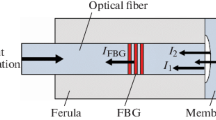Abstract
Currently, fiber Bragg gratings are the main type of sensor structure in fiber optic sensors. However, during their creation the protective-strength coating is removed, which reduces the strength and flexibility of the fiber and limits the field of application of such sensors. A solution to this problem could be the creation of a fiber-optic sensor using a new technology in which the protective-strength coating is not damaged, and the sensor structure is created using a fusion effect. When recording the sensor structure in a given area of the fiber, the conditions for generating a plasma focus are created, after the passage of which a structure of microneedles of various shapes is formed. Sensors created using such technology can operate in a wide temperature range. The aim of the present study is to determine the dependence of changes in the spectral characteristics of the sensor in the temperature range from 4 to 700 K.




Similar content being viewed by others
REFERENCES
Shcherbakova, V.A., Konin, Yu.A., Starikov, S.S., et al., Proc. 25th All-Russian Scientific Conference of Physics Students and Young Scientists, Yekaterinburg: ASF, 2019, p. 260.
Bufetov, I.A. and Dianov, E.M., Adv. Phys. Sci., 2005, vol. 175, no. 1, p. 100.
Shcherbakova, V.A., M.Sc. Thesis, 2020. https://nauchkor.ru/uploads/documents/5f27f743cd3d3e0001b2 ebae.pdf.
Konin, Yu.A., Bulatov, M.I., Shcherbakova, V.A., et al., Instrum. Exp. Tech., 2020, vol. 63, no. 4, p. 511. https://doi.org/10.1134/S0020441220040284
Reid, M.B., Opt. Eng., 1998, vol. 37, no. 1, p. 237. https://doi.org/10.1117/1.601610
Roths, J., Andrejevic, G., Kuttler, R., and Süßer, M., in Optical Fiber Sensors, OSA Technical Digest (CD), 2006, paper TuE81. https://doi.org/10.1364/OFS.2006.TuE81
Kashyap, R., Proc. X Int. Conf. on Lasers, Lake Tahoe, 1987, p. 859.
Kashyap, R. and Blow, K.J., Electron. Lett., 1988, vol. 24, no. 1, p. 47.
Kashyap, R., Sayles, A., and Cornwell, G.F., Proc. Soc. Photo-Opt. Instrum. Eng., 1996, vol. 2966, p. 586.
Author information
Authors and Affiliations
Corresponding author
Ethics declarations
The authors declare that they have no conflicts of interest.
About this article
Cite this article
Konin, Y.A., Petrov, A.A., Starikova, V.A. et al. Wide Temperature Range Fiber Optic Sensor. Bull. Russ. Acad. Sci. Phys. 86 (Suppl 1), S100–S103 (2022). https://doi.org/10.3103/S1062873822700472
Received:
Revised:
Accepted:
Published:
Issue Date:
DOI: https://doi.org/10.3103/S1062873822700472




